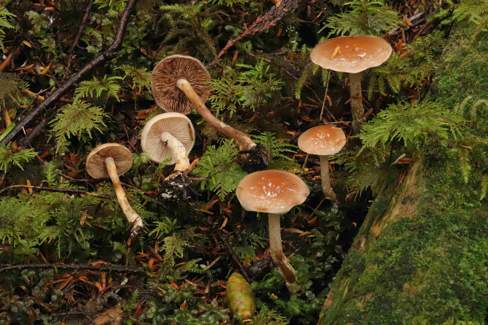 Hebeloma immutabile (Photo: H. J. Beker)
Hebeloma immutabile (Photo: H. J. Beker)Taxonomy
Full name: Hebeloma immutabile A.H. Sm., V.S. Evenson & Mitchel, The Veiled Species of Hebeloma in the Western United States: 98 (1983)Genus: Hebeloma
Section: Scabrispora
Types: UNITED STATES: Washington: Clallam, Mt Angeles, Olympic National Park (approx. 47.9955°N, 123.4653°W, alt. approx. 1950 m a.s.l.) in boreal woodland, 4 Oct. 1941, A.H. Smith (17538) (Holotype. herbarium acc. no. MICH 10751, HJB1000390).
- arrow_drop_downarrow_drop_upEtymology
- arrow_drop_downarrow_drop_upOriginal diagnosisPileus 2-4 cm latus, convexus vel planus, glutinosus, ad marginem minute squamulosus vel appendiculatus, glabrescens, obscure vinaceobrunneus; odor et gustus mitis. Lamellae confertae, latae, adnatae, subcinnamomeae. Stipes 4-7 cm longus, 2.5-4 mm crassus, sericeofibrillosus, brunneolus sed deorsum non brunnescens). Velum sparsim, evanescens. Sporae 8-10 x 5-5.5 μm, in "KOH" fulvae, valde dextrinoideae, verruculosae, inequilaterales. Cheilocystidia 26 -38 x 8-12 μm, utriformia vel clavata. Cuticula pileorum ixotrichoderma est. Hypoderma + cellulosa.
- arrow_drop_downarrow_drop_upEnglish translationPileus 2-4 cm broad, convex or applanate, glutinous, flocculose or appendiculate on the margin, becoming glabrous, dull vinaceous-brown; smell and taste mild. Lamellae crowded, broad, adnate, pale cinnamon. Stipe 4-7 cm long, 2.5-4 mm thick, fibrillose-silky, brownish (but not discolouring brown). Veil sparsely distributed, vanishing. Spores 8-10 x 5-5.5 μm, fulvous in KOH, strongly dextrinoid, slightly roughened, inequilateral. Cheilocystidia 26-38 x 8-12 μm, utriform or clavate. The pileus cuticle is an ixotrichoderm. Hypoderm more or less cellular.
References
Description
- arrow_drop_downarrow_drop_upThresholds
Description of Hebeloma immutabile based on 18 collections
- arrow_drop_downarrow_drop_upMacroscopic descriptionPileus: (6) 13–36 (67) mm diameter; shape often convex, occasionally broadly umbonate, rarely strongly umbonate; characters often remains of universal veil, rarely pubescent; margin characters usually smooth, rarely appendiculate or involute; viscosity tacky when moist; colour variation usually two color, rarely unicolour; colour at centre often yellowish brown, occasionally clay-red or ochraceous, rarely brick or cinnamon.
Lamellae: attachment usually emarginate, rarely adnate; maximum depth up to 5 mm; number of complete lamellae 40–60; presence of tears absent; white fimbriate edge often weak, occasionally absent.
Cortina presence: no.
Stipe: (29) 42–99 (114) x 2–6 (9) {median} x (2) 3–10 {basal} mm; stipe Q 7.4–24.3; base shape often clavate, occasionally cylindrical; floccosity often pruinose at apex, occasionally fibrillose or floccose, rarely velute; rooting no; thick rhizoids at base absent;
Context: Texture firm; stipe interior stuffed; stipe flesh discolouring often yes, rarely no or weak; slenderness measure 25.6–139.3; smell odourless; taste mild where recorded.
Spore deposit colour: umber.
Exsiccata characters: pileus blackening or stipe blackening.
- arrow_drop_downarrow_drop_upMicroscopic descriptionSpores: shape amygdaloid; colour in microscope brown, occasionally yellow brown; guttules yes. papilla no; Spore Code: O3 (O4); P2 P3; D3 (D4).
Basidia: 18–35 (37) x 5–8 (9) μm; ave. Q 3.2–4.0; spore arrangement 4 spored;
Cheilocystidia: main shape cylindrical; special features observed occasionally branching or septa; cheilocystidia ratios: A/M = 1.00–1.23; A/B = 0.95–1.24; B/M = 0.96–1.11.
Pleurocystidia: usually none seen, rarely only close to lamella edge.
Ixocutis: epicutis thickness (measured from exsiccata) up to 380 μm; ixocutis hyphae width up to 5 μm; ixocutis hyphae encrustation variable; shape of trama elements beneath subcutis cylindrical up to 11 μm wide.
Caulocystidia: Similar to cheilocystidia but larger, up to 80 μm.
- arrow_drop_downarrow_drop_upSpore measurements
- arrow_drop_downarrow_drop_upCheilocystidia measurements
- arrow_drop_downarrow_drop_upHabitat and distributionHebeloma immutabile's preferred habitat appears to be boreal, coniferous woodland. Where only one possible associate was recorded, that associate has always been Tsuga (family Pinaceae). We have additional records where Picea, Pseudotsuga, Notholithocarpus and Abies were recorded as possible associates, but in these cases a number of possible associates were mentioned. Overall the most commonly recorded families are Pinaceae (90.9%) and Fagaceae (9.1%) The growth habit of our collections was often scattered and occasionally gregarious.
According to our current collections, the species is found only in Northern America. On the continent, collections has been found in the WWF biomes The World Wildlife Fund (WWF) have divided the world into 867 terrestrial ecoregions. The ecoregion here is estimated by mapping from the GPS coordinates of the collection using data made available by Dinerstein et al (2017). Use this webtool to explore the ecoregions visually or see a full list of current ecoregions on Wikipedia. temperate conifer forests (77.8%) and unknown biome (11.1%), specifically including the ecoregions: Central Pacific Northwest coastal forests (38.9%), Queen Charlotte Islands conifer forests (16.7%), Northern Pacific Alaskan coastal forests (11.1%) and Unknown region (11.1%). From collector information, it appears collections have been found in the 1.1 Forest – Boreal (80.0%) and 1.4 Forest – Temperate (20.0%) IUCN habitats We map from the collector's description of the habitat to the International Union for Conservation of Nature (IUCN)'s definition using a standardised set of rules. Please see this page for a full list of IUCN habitats.. Within Northern America we have records from Western Canada (British Columbia), Subarctic America (Alaska), Northwestern U.S.A. (Washington and Oregon) and Southwestern U.S.A. (California).
Geographic distribution
Phenology
- arrow_drop_downarrow_drop_upAdditional cited collections